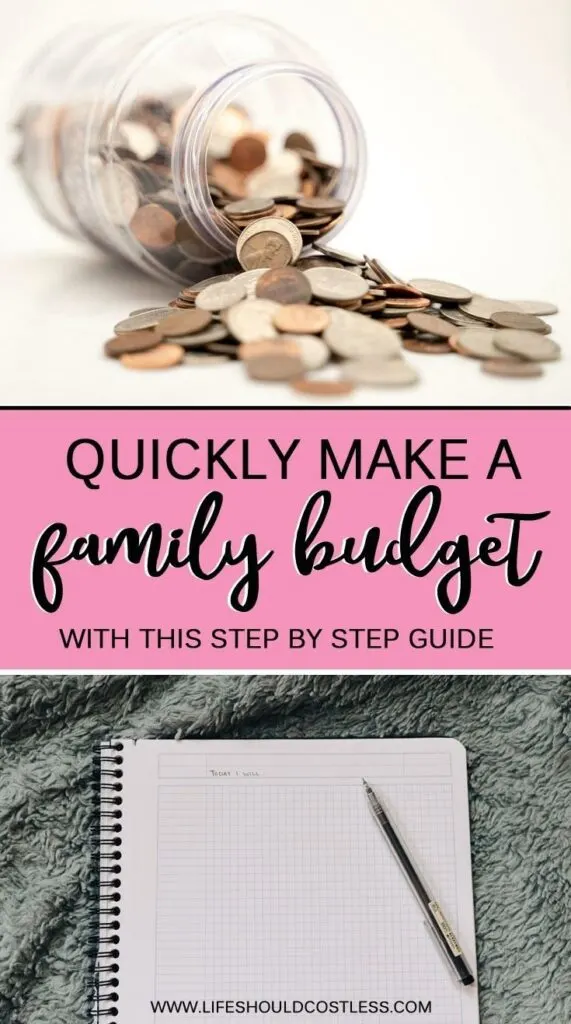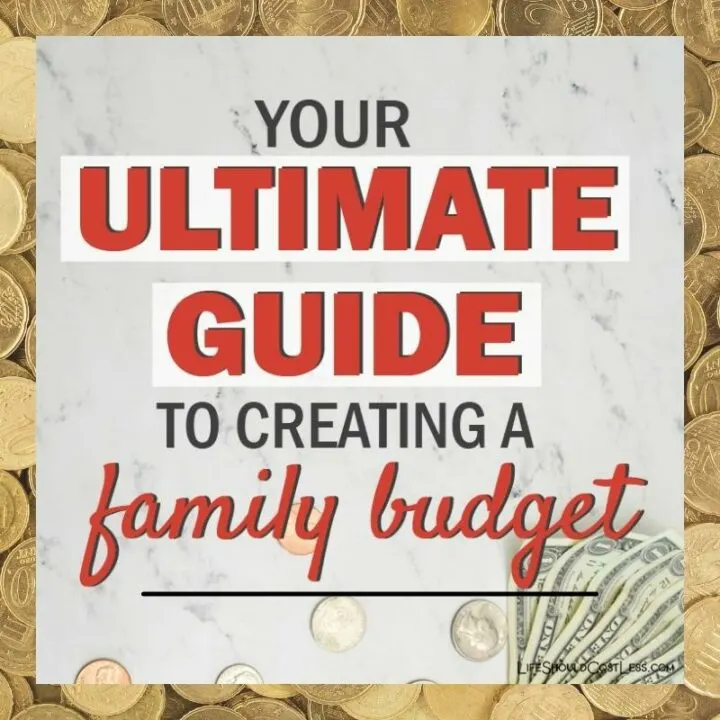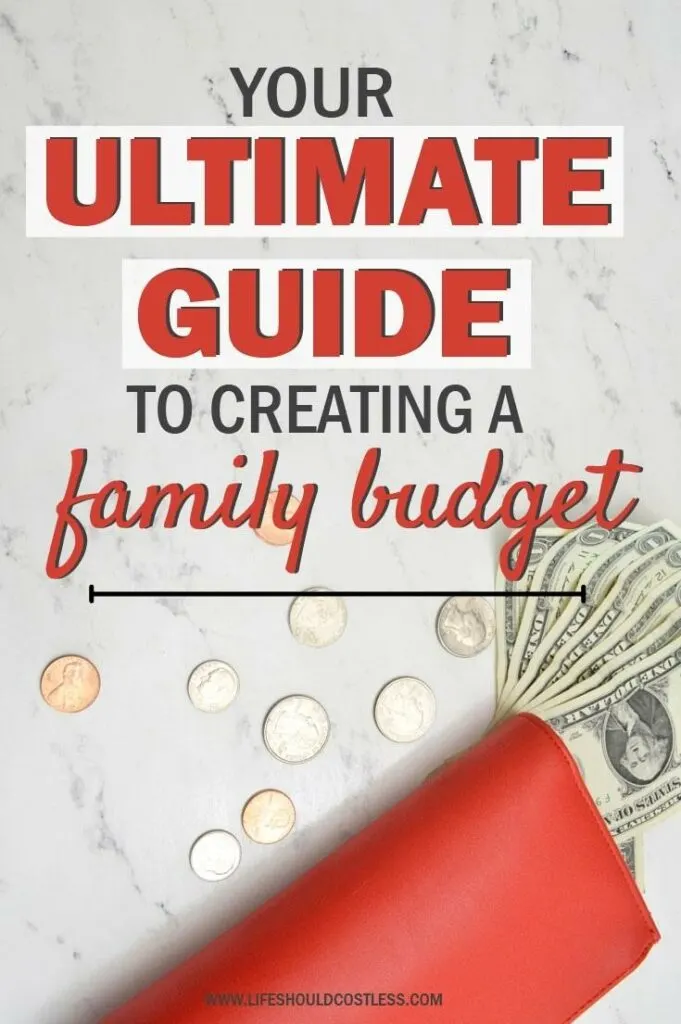Knowing where to even start, when creating a family budget is the first step to financial success and freedom. I have gathered my thoughts, and a bit of life experience, to share with you some tips for creating the Ultimate Guide to help you along your way to financial wellbeing.

How to create a family budget
Whether you have decided to get your family’s finances in order, or just vowed to finally start a savings account to fall back on, creating a family budget is always a great idea.
A budget is a great way to see where you may be spending your money, learn how to manage your income in a more beneficial way, and even save a little bit of money in the process.
While that all sounds amazing, actually creating a budget and putting it into practice is another story.
However, with this simple family budget guide, you’ll have your family’s budget outlined in no time.
Pick Your Budgeting Tool
Before you start planning your budget, it is always a good idea to decide on a budgeting method.
There are a variety of ways your family can keep track of their budget from month to month. Here are a few easy budgeting options to consider:
- Pen and paper. Simply write down your budget and budget categories each month and keep track of them manually.
- Spreadsheet. If you’re more of a computer person, it may be easier for you to create a budget spreadsheet to help you keep track of your family’s income and expenses each month.
- Online budgeting tool. Another easy computer-drive option is using an online budgeting tool, like mint.com. This type of tool allows you to connect directly to your bank account and easily track your income and expenses in real-time.
- Budgeting app. If you would rather use your phone to track your family’s budget, there are a variety of handy apps, like You Need a Budget, you can use.
When deciding on a budgeting tool for your family, make sure the tool is easily accessible by both you and your significant other, and simple to adjust as the year progresses.
Any tool you pick should also be convenient to use and simple enough for you to manage on a day-to-day basis to ensure you stick to your budget and budget tracking from one month to the next.
Budget With Your Bank Statements
There really is no better way to track your family’s income and expenses than taking a look at your past bank statements or credit card statements. By examining your monthly statements, you’ll be able to see exactly where your money is going every month, as well as exactly how much money you have coming in.
Bank statements are not the only paperwork you’ll need to create an accurate budget. It’s also a good idea to layout all your bills and sources of income in front of you, including:
- Paychecks and other income
- Receipts from monthly purchases
- Regular monthly bills
- Credit card statements
- Recurring annual expenses
Outline Your Income
Now it’s time to get into the act of budgeting. And the first step to building a family budget is to see exactly how much money you have to spend each month.
That means outlining your monthly income, including you and/or your significant other’s regular paychecks and any other sources of income your family has.
Categorize Your Expenses
Next, take a look at the money your family spends each month. These expenses will typically fall into one of two categories: fixed and variable expenses. Fixed expenses are all expenses that occur each month, like some utility bills, mortgage payments, and student loan payments.
Variable expenses are all expenses that change from month to month, like grocery shopping and entertainment expenses. While fixed expenses will remain constant from month to month, these variable expenses may change.
When including these types of expenses in your budget, it’s best to estimate the amount of money you think you’ll spend each month based on past spending habits.
As you work through your family’s monthly expenses, it’s a good idea to break each expense into more detailed categories to allow you to easily adjust your spending in various categories.
Your family’s budget may have categories like these:
- Utilities (water, electricity, cable, internet, etc.)
- Debt (mortgage payments, credit card bills, student loan payments, etc.)
- Variable monthly expenses (groceries, gas, etc.)
- Discretionary spending (entertainment, clothing, etc.)
While these basic categories are a great start, your family’s budget may also include additional categories that incorporate other areas of spending specific to your budget.
Don’t Forget Annual Expenses
It’s easy to get lost in the regular expenses your family has from month to month, it’s also important to remember to include annual expenses into your family budget.
You may not pay these expenses directly every month, setting money aside to prepare for these expenses will help you stay on track throughout the year.
These annual expenses should also be included in your budget:
- Property taxes
- Annual vehicle maintenance
- Annual membership dues
- Vehicle registration
- Annual home maintenance
- HOA fees
To include these annual fees into your monthly budget, simply take the total yearly cost and divide it by 12. Then add that figure into your budget each month to automatically set aside the correct amount for the entire year.
Figure Your Net Income
After outlining all your income and expenses, it’s time to calculate your family’s net income. Your net income is your income minus all your expenses.
If your net income for the month comes out negative, it’s time to make some adjustments because that means your family is spending more money than you’re making.
To adjust your family budget, start by taking a look at your variable spending. Areas like entertainment expenses, dining out, and expenses related to hobbies are easy to adjust (if exercising a little self control anyway). But, you could also consider cutting back on some of your fixed expenses, like your cable bill or gym membership, to reduce your family’s monthly spending.
Keep Track of Your Spending
Just because you’re finished creating your family’s budget doesn’t mean you’re finished budgeting! While the hard part is behind you, your family still needs to track your spending each month to be sure you’re staying on budget.
It’s a good idea to check your budget at least once a week to make sure you’re staying on track and to give you time to adjust your spending if you notice you’re getting close to your budget allotment in certain categories.
Make Adjustments to Your Family Budget
Tracking your spending will give you a chance to adjust your budget, as needed. If you notice yourself overspending in an area, it may be an indicator that your budget needs to be changed.
Always make sure to evenly adjust your budget – if you add money to one category, that same amount must be deducted from another to ensure your budget stays balanced.
What to Do with Extras
One great thing about creating a family budget is that you can make your family’s money work for you. If your especially frugal from month to month and are able to leave yourself extra income, you may be wondering what to do with that extra money.
Here are a few good ideas:
- Pay off debt. The first thing you should do with any extra money left over each month is to pay off your debt. Credit card bills, student loans, and your mortgage are all great places to spend that extra cash.
- Put it in savings. If you have paid off all or most of your debt, placing that extra income into a savings account for a rainy day is always a good idea.
- Invest it. After paying off your debt and building yourself an emergency fund, another great way to use extra cash is to invest it. Investing will help your family increase their income and give you additional income during your retirement.
- Spend it. Another great way to use your extra income (after paying off your debt and creating an emergency fund) is to find a way to spend it. Rewarding yourself with a fun family vacation or a new TV is a great way to celebrate the fact that you stayed on budget throughout the year.
How to do a simple family budget with decreased/loss of/ or less income?:
This is a subject that is an incredibly tough situation to be in… believe me, a single working mom of four practically has to worry about budgeting in her sleep, so I’m going to share some things that I do when things are really tight.
Take a piece of paper and start writing down your expenses…and then strip those expenses to the absolute bare essentials…I’m talking write down your rent/mortgage payment amount, gas, electricity, water, sewer, gas, any car payment, insurance, debt payments…then add that number together. If you are now making less than this amount, I hate to be the bearer of bad news, but it’s time to figure out some big things…
Life throws us some MAJOR hurdles sometimes…and it’s ok and healthy even to have a good cry when one comes your way…but it’s also important to not just sit there and wallow feeling sorry for ourselves…because there will always be rainy days at some point.
Sometimes we have to learn to be proactive and we absolutely need to think about what habits that we have that are adding to our financial burdens (yes, there needs to be some accountability for the role we play in our own financial suffering and some of those things could be: overeating, cigarettes, hobbies we can’t really afford, video games, subscriptions to anything and everything we want, alcohol or other addictions)
At this point I would ask myself:
“Do you have anything that you can sell to reduce your debt payments?”
“Is there a place I can move to that will decrease my living expenses?”
“Are there any odd jobs I can take while I look for a more reliable source of main income?”
“What am I wasting my money on that I can get rid of (subscriptions, memberships I don’t use, expensive habits I shouldn’t have) ?”
Once I have done all of the “heavy lifting” in getting the expenses under control (cutting away the fat), then I can see how far my income can realistically stretch in order to create my new budget.
When you get it to the “bare bones” that is the only way to really be able to begin the budgeting process with less income and actually know what you’re dealing with…at which point some of my other tips from above may help guide you in creating that new, lower income budget.
That about wraps up my ideas to help you in family budget ideas. Remember that there is no wrong or right way to make a budget…and if you fall on your face one month, don’t let that discourage you from your financial goals… just pick yourself up, dust yourself off, and get right back on track. And DO NOT beat yourself up for being human and having to get caught back up from your mess-up.
Thanks so much for stopping by my blog and supporting my endeavors to make people’s lives a little easier/better/more affordable. If you liked this post, or found it helpful in any way, please make sure to share it with your family, friends, and co-workers via social media…or you could even send them the direct link via email. Whichever way you choose to spread the love, I super appreciate it! ~Sarah

How To Follow & Support This Site
- If you would like to subscribe to my email list, go here.
- Make sure to follow along via social media, by going here.
- If you would like to learn how to really show your support to this site (at no cost to you), go here.
- If you would like to make a direct donation to the site, go here.
P.S. You if you would really like to increase your knowledge when it comes to creating a family budget, you may want to check out my Budget Section too.
Here are links to several of my other financially savvy posts to also help you on your financial journey:
For those of you that want to pin this post to a board on Pinterest, here is a second “pinnable” image option for that:

*This post was originally posted to this website on December 24, 2019 and has since been updated to improve user experience, stay current, and become more shareable.
